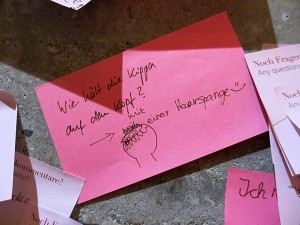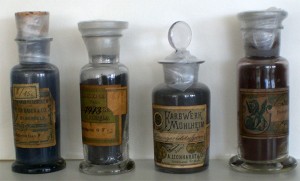“How does a kippah stay on?”
Our current special exhibition “The Whole Truth… everything you always wanted to know about Jews” is based on 30 questions posed to the Jewish Museum Berlin or its staff over the past few years. In the exhibition, visitors have their own opportunity to ask questions or to leave comments on post-it notes. Some of these questions will be answered here in our blog. This month’s question is: “How does a kippah stay on?”

“How does a kippah stay on?”
© photo: Anina Falasca, Jewish Museum Berlin
If a non-Jew tries on a kippah, it usually falls off. This isn’t fair, but let’s examine the circumstances more closely. When tourists visit the Jewish cemetery in Prague, all men are asked to wear a kippah. Those who travel kippah-free are requested to don a blue, sharply-creased, circular piece of paper. The precarious kippah is inevitably subjected to the winds off the Vltava and flutters away. Comparably, a non-Jewish man attending a synagogue ceremony such as a marriage or Bar Mitzvah, will usually be requested to wear a kippah. Here, a stiff yet slippery synthetic satin kippah is ubiquitous. No guest stands a chance.
What then is the secret to making a kippah stay on? → continue reading
A museum has a thousand objects in its possession, but sometimes just the right one is missing! Last winter when I was preparinga new showcase in the permanent exhibition on the Nobel Prize winner Paul Ehrlich, I didn’t have enough pieces to create a coherent presentation for the exhibit.
I wanted to illustrate Paul Ehrlich’s achievement in the field of medicine with documents and paraphernalia from his work, but didn’t find any appropriate objects in our collection. Nonetheless this significant scientist was to appear in our exhibition. He developed a cure for syphilis, founded modern cancer research, and brought many important, trendsetting research results to light.

Jars of dye that Paul Ehrlich needed for his famous experiments with dye, Paul Ehrlich Institute, Langen
© photo: Christiane Bauer, Jewish Museum Berlin
So I began to search for suitable exhibit pieces and found my way to Hessen: both the Paul Ehrlich Institute in Langen and the Georg Speyer House in Frankfurt – Paul Ehrlich’s last and most significant workplace – have an impressive store of items related to his work and influence. But how to bring these objects to the museum in Berlin? → continue reading

